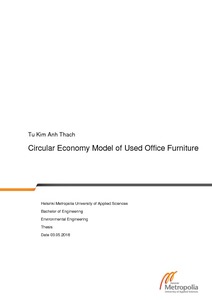Circular Economy Model of Used Office Furniture
Kim Anh Thach, Tu (2018)
Kim Anh Thach, Tu
Metropolia Ammattikorkeakoulu
2018
All rights reserved
Julkaisun pysyvä osoite on
https://urn.fi/URN:NBN:fi:amk-201805046513
https://urn.fi/URN:NBN:fi:amk-201805046513
Tiivistelmä
Circular economy is a newly developed model that follows the principles of a “closed-loop” system. It functions as a perpetual machine which uses the energy it generates to fuel itself. Any element added to the circular system will remain there indefinitely, instead of being disposed of. In other words, products are reused and recycled for as long as possible. Such practice can negate a significant amount of resources, time and money due to its efficient consumption rate. This thesis focuses on the benefits of circular economy of reusing and recycling office waste, particularly furniture.
There are three major parts in this thesis: literary research, calculation and data, and furniture inventory. The location selected for furniture study is the Metropolia campus at Bulevardi 31. A set of common, used products designated for disposal was analyzed. Their measurements, origins and materials were identified as a part of environmental impact assessment in the laboratory. This process assists the final evaluation on the furniture’s final destination. The three main factors chosen for the assessment are carbon emission, energy consumption and financial cost. These factors cover a plethora of sub-factors, such as material extraction, manufacturing, and transportation. Finally, one of the three most suitable disposal approaches was chosen: reuse, recycle or waste to energy combustion. Obtained data and estimations are based on previous researches on furniture management.
The conclusion provides final calculations and data from each disposal solution. These results can be utilized in the future in the event any more furniture needs disposing. Taking advantage of the outcomes, the responsible department of Metropolia can devise an appropriate plan to relocate old furniture in the facility. It is important to note that estimations have been optimized to be as close to the desired results as possible. In practice, some unprecedented elements may arise and alter the output.
There are three major parts in this thesis: literary research, calculation and data, and furniture inventory. The location selected for furniture study is the Metropolia campus at Bulevardi 31. A set of common, used products designated for disposal was analyzed. Their measurements, origins and materials were identified as a part of environmental impact assessment in the laboratory. This process assists the final evaluation on the furniture’s final destination. The three main factors chosen for the assessment are carbon emission, energy consumption and financial cost. These factors cover a plethora of sub-factors, such as material extraction, manufacturing, and transportation. Finally, one of the three most suitable disposal approaches was chosen: reuse, recycle or waste to energy combustion. Obtained data and estimations are based on previous researches on furniture management.
The conclusion provides final calculations and data from each disposal solution. These results can be utilized in the future in the event any more furniture needs disposing. Taking advantage of the outcomes, the responsible department of Metropolia can devise an appropriate plan to relocate old furniture in the facility. It is important to note that estimations have been optimized to be as close to the desired results as possible. In practice, some unprecedented elements may arise and alter the output.
